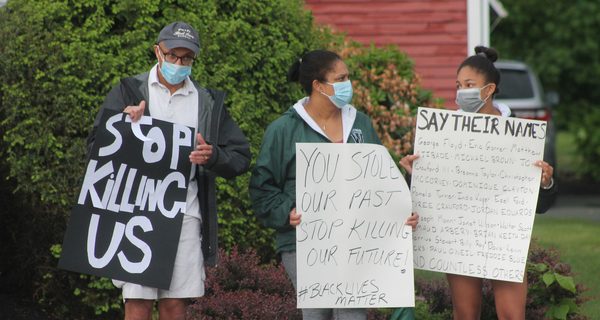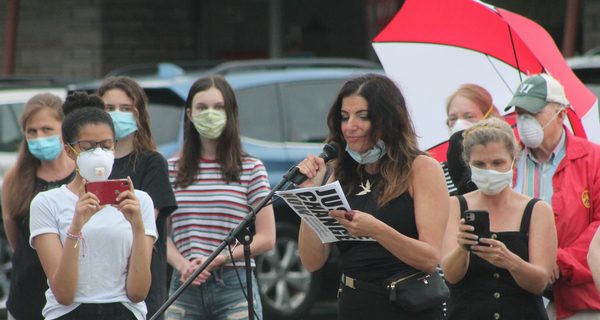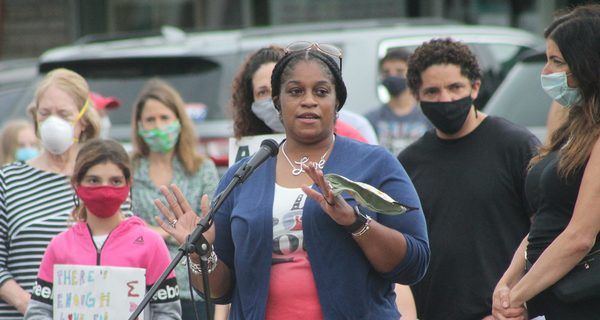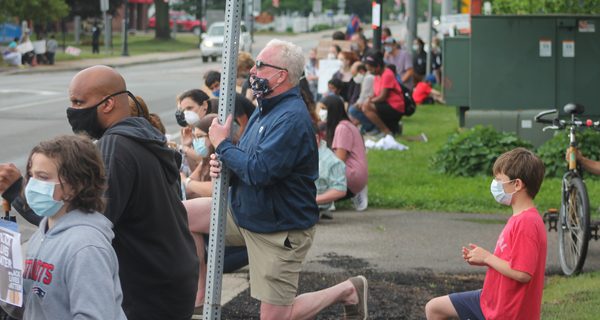During a moment of silence, the crowd took a knee.
By James Kinneen
Hometown Weekly Reporter
It’s uncomfortable to stand in the rain. It’s far more uncomfortable to have a 200-pound man kneel on your neck for eight minutes forty-six seconds as you use your last dying breaths to beg for mercy. So, despite gloomy weather and a torrential downpour that cleared just before it, the Westwood community came out in droves for Saturday night’s Peace and Justice Vigil for Black lives Taken at the corner of Gay and High Street.
With sidewalk chalk circles to maintain social distancing, families and individuals lined the sidewalk holding signs that ranged from “Black Lives Matter” and “No Justice, No Peace” to “are you brave enough to dismantle a system built to benefit you” and “a measure of privilege is how little you have to think about it in a day.” By far the most powerful signs were held a black family, which read “you stole our past, stop killing our future” and simply: “stop killing us.”

With a microphone just outside of the post office parking lot, the event began with Kerry O’Leary asking the crowd to chant “black lives matter!” for one minute straight. Then, Hania Khuri-Trapper stepped up to the microphone and gave a speech.

A lifelong resident of Westwood, Khuri-Trapper noted that she is the child of Lebanese immigrants and grew up dealing with anti-Arab taunts. This led to her developing a sense of empathy with other minority groups. She also acknowledged that “here in Westwood, it’s easy to shield our children from life in neighborhoods only a few miles away,” but that “if each one of every one of us in this 87 percent white town did our part to be, as Dr. Kendi says, anti-racist, not just not racist, then we could help alleviate the burden and weight our black brothers and sisters have to bear in this fight for fairness, integrity and life.”
After her, Monique Damon got up to speak. A black mother who has raised her son in Westwood, Damon spoke of how the fight against racism needs to start at home and outlined the racism her child has dealt with in the town. At one point, she talked about how he should not continue being asked if he’s a METCO student by teachers, when he’s been here since kindergarten. This got a big cheer from the assorted black families scattered around the protest, who’d obviously dealt with the same issue.

What Damon didn’t do, however, was name any specific Westwood teachers. With such an emotionally-charged public forum at her disposal, it likely would have meant the end of that person’s career and a huge backlash against them.
“It’s not about calling anyone out,” she told me after the event, when I asked her why she hadn’t. “It’s to make a change. I wanted to put it out there, that it’s happening, and people need to know. Me and my son have kept quiet for a long time, so I just thought they needed to know; this is the school your children go to, and he’s dealing with that. These are the teachers that are teaching your kids.”
After eighth-grader Abby O’Leary read a poem, Anna Reilly asked the crowd for a moment of silence in honor of those who’ve been murdered, the massive crater that left for their families, and for all the things they could have been. During the moment of silence, the crowd took a knee for around two minutes.
“I just want to point out how long that felt,” Reilly noted after the moment ended. “George Floyd was held down and murdered for eight minutes, forty six seconds.”
After the event, Khuri-Trapper noted that while there were some things she might have changed (because of the social distancing rules, people at the far ends of the vigil may not have have clearly heard the speakers), overall, she was very pleased with the outcome.

“I’m incredibly thrilled with how it turned out. We were initially thinking we’d get 30 people or something like that, and we’d all stand around this little corner. We were originally going to do it on the other side of town, and then we merged with a couple people on this side, and we put it on social media. I didn’t know how the response would be in Westwood, but I couldn’t be happier with how many people showed up, lining the streets all the way down. I’m really moved that the average person came out today and is showing their support for Black Lives Matter, and for what’s happening in the country right now. It’s really heartbreaking. I feel like complacency is usually what happens in the suburbs, in these white places that are not affected. But this is showing that people have empathy and are starting to see there’s going to be a change. If people at this level, in the suburbs outside of Boston, are coming out in these numbers, I do feel like there’s a lot of hope. It’s not going to end here. This is a movement.”
There was a brief moment during which Khuri-Trapper asked the crowd if anyone wanted to come to the microphone and say something. Nobody did. Khuri-Trapper argued that many people were nervous about speaking in front of such a large crowd, and that even if people didn’t want to speak in that environment, they would find another way.
“I’m hoping we offer people enough resources and support so they can express themselves and also be part of the change," she explained. "Whatever we can do.”
While the lack of people looking to speak may have felt awkward at the time, perhaps it's a good sign. Maybe it means that even in a wealthy suburb with an overwhelmingly white population like Westwood, people are finally willing to listen.






















